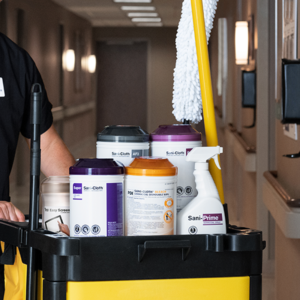Interventional Care


We notice that you are visiting us from . This site only services US-based visitors. Would you like to visit the site that is appropriate for your location?

We recently engaged members of our Clinical Affairs Team for support in answering frequently asked questions around the flood of information coming in around COVID-19 pandemic. Here are some Q&As specific to the use of cleaners and disinfectants during the pandemic:
Q. Has the COVID-19 pandemic led to unsafe use of disinfectants?
A. Since March, there has been an increase in the daily number of calls (2019 v. 2020) to poison control centers in the US regarding exposures to cleaners and disinfectants, specifically with household use, as a result of individuals’ attempts to protect themselves against SARS-CoV-2. The largest percent increase was seen in exposures among children aged < 5 years old. Bleach accounted for the greatest percent increase (62.1%) with alcohol free disinfectants (36.7%) and hand sanitizers (36.7%) showing substantial increases as well. Regarding exposure type, inhalation represented the largest percent increase – 35.3% – for all cleaners and an increase of 108.8% for all disinfectants.[1]
Q. What are the reasons for the unsafe use of disinfectants?
A. According to an opt-in internet panel survey of 502 U.S. adults regarding knowledge and practices of household cleaning/disinfection conducted in May 2020, knowledge gaps were identified in several areas:
Q. What are some of the unsafe practices that people have engaged in as reported in the internet survey?
A. Thirty-nine percent of the survey respondents reported as engaging in some unsafe practices in order to prevent COVID-19 infection. These practices included:
Respondents who engaged in unsafe practices were more likely to have experienced an adverse event associated with that practice.[3]
Q. What are the best practices to follow when using cleaners/disinfectants?
A. It is important for people to continue to follow current CDC and public health guidance for prevention measures against COVID-19. These measures include frequent hand hygiene and frequent cleaning/disinfection of high-touch surfaces. When using a cleaner/disinfectant, it is important to:[4]
[1] Chang A, Schnall AH, Law R, et al. Cleaning and disinfectant chemical exposures and temporal associations with COVID-19—National Poison Data System, United States, January 1, 2020–March 31, 2020. MMWR Morb Mortal Wkly Rep 2020;69:496–8.
[2],3,4 Gharpure R, Hunter CM, Schnall AH, et al. Knowledge and Practices Regarding Safe Household Cleaning and Disinfection for COVID-19 Prevention — United States, May 2020. MMWR Morb Mortal Wkly Rep 2020;69:705–709. DOI: http://dx.doi.org/10.15585/mmwr.mm6923e2